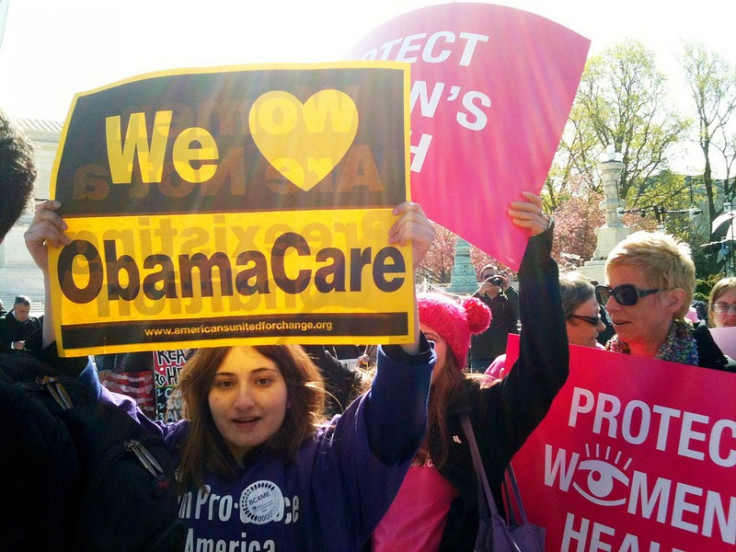From Roe v. Wade to Citizens United: 5 Landmark U.S. Supreme Court Cases That Changed Our Lives

In a 5-4 decision that shocked the country, the U.S. Supreme Court sided with the Obama administration and upheld the individual mandate provision of the 2010 Affordable Care Act. The decision's impact will be felt across the country, from small business owners to those without health insurance. It marks the latest landmark Supreme Court ruling that affects our daily lives.
Chief Justice John Roberts and Justices Ruth Bader Ginsburg, Stephen Breyer, Sonya Sotomayor, and Elena Kagan were the five Supreme Court justices in the majority while Antonin Scalia, Anthony Kennedy, Clarence Thomas and Samuel Alito were the dissenting minority.
The individual mandate, as it is known, would force uninsured Americans to get health insurance or face a tax that penalizes them for not complying with the law. The provision of the Affordable Health Care Act was a main source of contention for proponents and opponents of the law.
Here is a look back at other landmark U.S. Supreme Court decisions and their impact on American society:
- Roe v. Wade (1973)
Jane Roe (later identified as Norma Leah McCorvey,) a single woman from Dallas County, Texas, challenged the abortion laws of her state in this landmark case.
The law at the time allowed abortions only if the procedure was needed to save the life of the mother.
The Supreme Court ruled in her favor, and the decision made abortions in the first trimester legal and abortions in the second trimester legal if the procedure is conducted for health reasons.
The court decided that the Texas abortion statutes, as a unit, must fall because a woman's right to privacy includes whether she wants to have a child.
Ironically, McCorvey is now an anti-abortion activist.
You can read the Supreme Court's full decision here.
- Brown v. Board of Education of Topeka (1954)
Chief Justice Earl Warren's court's historic and unanimous decision in Brown v. Board of Education ended racial segregation in public schools, overturning the separate but equal ruling in the 1896 Supreme Court case Plessy v. Ferguson.
The case is seen as a watershed moment for civil rights.
We come then to the question presented: Does segregation of children in public schools solely on the basis of race, even though the physical facilities and other tangible factors may be equal, deprive the children of the minority group of equal educational opportunities? wrote Chief Justice Earl Warren. We believe that it does.
- Miranda v. Arizona (1966)
The terms Miranda rights and Miranda warning were coined following this historic Supreme Court case that established that criminal suspects must be told of their rights against self-incrimination.
Ernesto Miranda confessed in a written statement to kidnap, rape and armed robbery charges, but the Arizona police officers who got the confession did so without telling him that he had a right to an attorney.
The Supreme Court case threw out the confession (Miranda was still ultimately convicted due to other evidence against him) and established the Miranda rights that we all know from episodes of Cops and other television shows: You have the right to remain silent ...
- Citizens United v. Federal Election Commission (2010)
The Roberts Court ruled in the Citizens United case that corporations and unions could contribute unlimited amounts of money to political campaigns, deciding that past election laws violated the First Amendment. The court effectively said political contributions are a form of free speech and cannot be limited.
Proponents of the ruling say prior election law stifled the influence of corporations while opponents of the decision argue the landmark case gives too much power to corporations and dilutes the power of individual Americans. In real-life terms, the ruling has made it possible for groups known as Super PACs to spend all the money they want on campaigning -- provided they do not communicate with any one politician's campaign.
- Bush v. Gore (2000)
This landmark ruling ended the Florida recount of 2000 in the most contested presidential election in the nation's history, that culminated in then-Texas Gov. George W. Bush ascending to the presidency.
Bush's lawyers successfully argued that the recount was unconstitutional because there was no statewide standard for determining what constitutes a legal vote (remember hanging chads and footage of Board of Elections workers contorting paper ballots and squinting?)
The court also found that time constraints would limit Florida's ability to come up with such a standard, and its decision left then-Vice President Al Gore without any options to contest Florida Secretary of State Katherine Harris' certification that Bush won the state.
In its decision, the Supreme Court acknowledged its uneasiness in how its decision influenced the outcome of the election.
None are more conscious of the vital limits on judicial authority than are the members of this Court, and none stand more in admiration of the Constitution's design to leave the selection of the President to the people, through their legislatures, and to the political sphere, the court wrote. When contending parties invoke the process of the courts, however, it becomes our unsought responsibility to resolve the federal and constitutional issues the judicial system has been forced to confront.
© Copyright IBTimes 2024. All rights reserved.






















